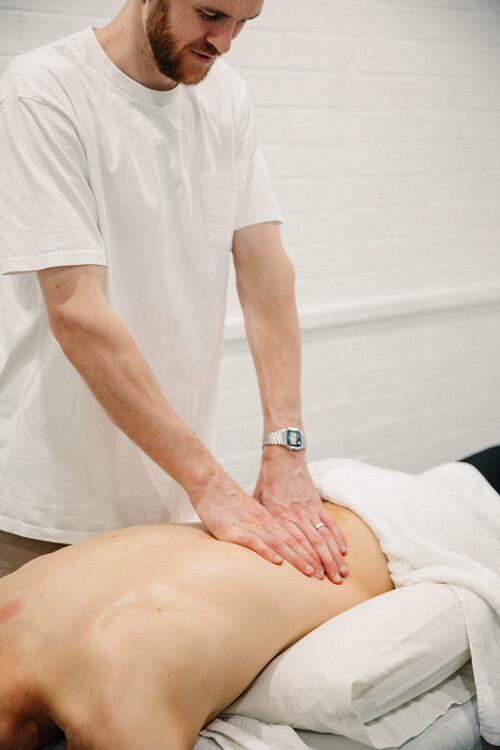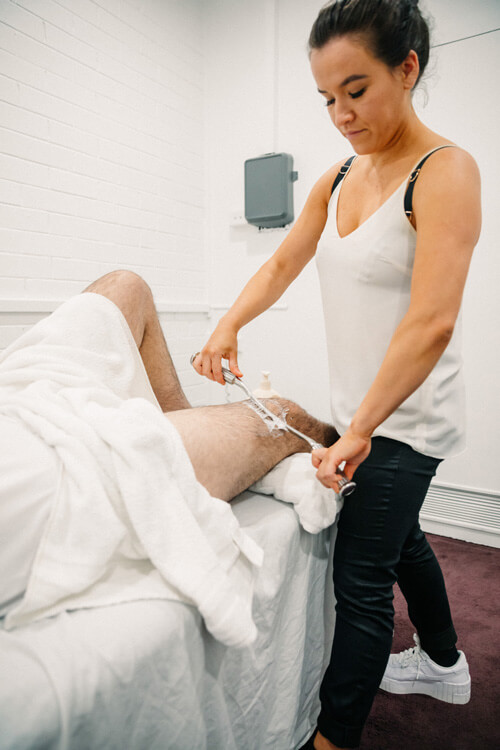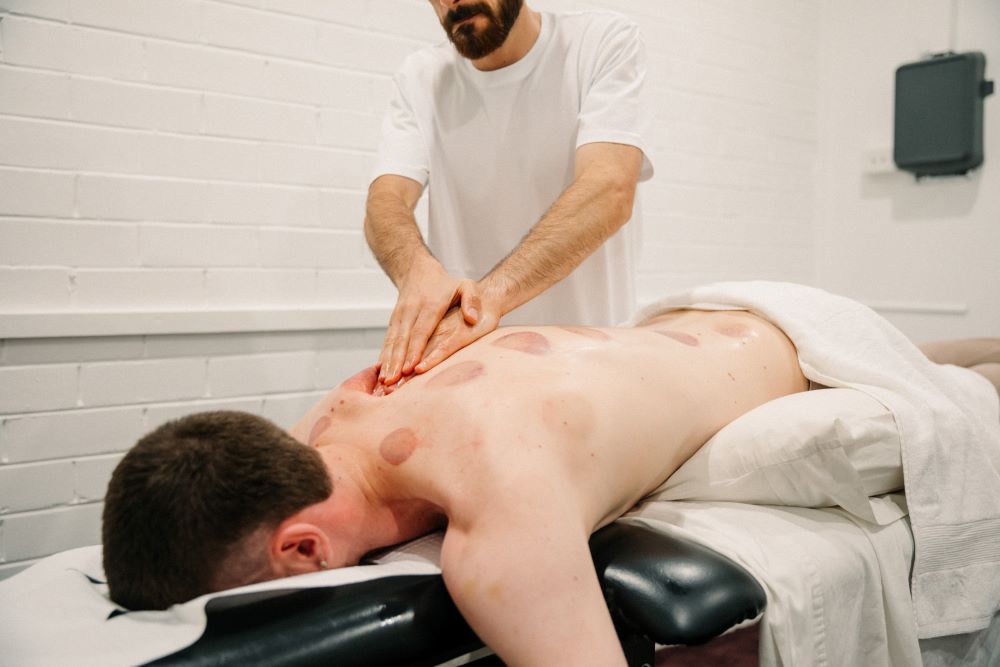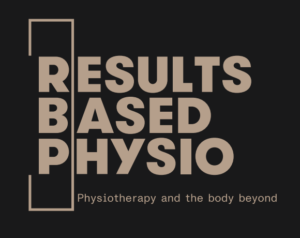Treatment Benefits.
At Results Based Physiotherapy, we truly pride ourselves on the results we get with our clients – this means that we have a 10/10 service from start to finish.
A big focus of ours, and our point of difference to all other Physiotherapists, is our hands on treatments and manual therapy skills. We believe that the hands on component and physical touch facilitates and encourages the healing process of the body. We use our clinical skills to determine what and where the injury, pain or dysfunction is, and we use our hands on skills to remove the blockage that is preventing your body from healing.
At RBP we have an arsenal of manual therapy methods which include:
- Deep Tissue Massage
- Dry Needling
- Fire and Vacuum cupping
- Spinal and Extremity (hip, knee, ankle, shoulder, elbow, wrist) Joint Adjustments / Manipulation
- Scraping / Instrument Assisted Soft Tissue Massage
- Electro-Dry Needling
There are many benefits to hands on treatment, but the main benefits to manual therapy include:
- Improvement in the body’s ability to heal itself
- Pain relief
- Restoration and improvement in joint and muscular range of motion / quality of movement
- Improvement in muscular and joint function (power and strength)
- Improvement in vascular (blood) supply to the treated areas
- Improvement in sleep quality and ability to physically relax


Now these benefits are always discussed when describing what ‘benefits’ does manual therapy provide, but what does this actually mean and how does the body do the things mentioned above?
This is where we reason with science and our own clinical experience. We reason these benefits with science because science helps us describe the processes that occur in the body through manual therapy, and our own clinical experience has shown us what science cannot yet explain but yet happens everytime we perform these treatments.
The healing effects of treatments include:
- Faster and focused local tissue healing (muscle recovery).
- Vasodilation of blood vessels through the release of histamine and stimulation of nerve endings. Both of these promote systemic vasodilation to local tissue and organs. This basically means that through mechanical stimulation (touch), the body will widen it’s blood vessels to increase the amount of blood flow and supply to the areas getting massaged and the whole body.
- Production of local inflammation to the injured tissue which initiates the healing cycle.
- Cellular signalling to produce more Mitochondria (powerhouses / fuel of the cells) in the muscle tissue.
- Reduced evidence of ‘stressed’ cells in the muscle tissue.
- Pain relief
- Restoration of joint and muscular performance, and range of motion quality
- Improved ability to rest, sleep and physically relax (refer to ‘Improvement in sleep quality and ability to physically relax’)
How does manual therapy improve muscular strength and power, and improve joint and muscular range of motion / quality of movement?
Manual therapy reduces symptoms of pain, muscular tightness and joint stiffness through several processes.
When pain is present, it creates an inhibitory effect on the muscular system via the nervous system – this means that when pain is present, your muscles will underperform and be ‘weaker’ than what they would normally be without pain present. This innate mechanism is designed to protect your body from further potential damage by reducing the body’s ability to physically perform – a warning system you could say.
So if manual therapy creates a reduction in pain, incidentally the nervous system will allow the body’s muscular system to function better and therefore produce all things that muscles do – greater strength, power, endurance, joint and muscular range of motion (flexibility), and quality of movement.
Pain signals are transferred from the injured muscle/joint/bone to the brain by specific neurons called nociceptive neurons. These neurons detect chemical and mechanical indicators of stress in the tissue and relay that to the brain as the sensation of pain.
Chemical indicators include molecules such as histamine and bradykinin which are released in response to inflammation. Mechanical indicators include pressure and tension caused by extended muscle contraction. Physiotherapy targets both of these pain indicators at the source, by decreasing inflammation and directly addressing muscular dysfunction.
Many people experience pain during or directly after manual treatments such as deep tissue massage and Instrument Assisted Soft Tissue Massage (IASTM) because these techniques stimulate an inflammatory response. An inflammatory response is necessary to initiate a healing response. This response stimulates the vascular system which in turn increases blood flow to the damaged tissue. Increased blood flow promotes the tissue’s healing and waste removal processes, hence accelerating recovery.
How does manual therapy promote greater vascular supply to the treated areas?
To understand how manual therapy works, it is necessary to understand what is in blood and how will more blood delivery to the area improve the body’s ability to heal. Blood makes up for roughly ~10% of total body weight. Blood contains white blood cells, red blood cells and plasma.
- Plasma: this is the liquid component of blood and carries proteins, water, sugar, fats and salts. The plasma transports blood cells throughout the body and also delivers nutrients, antibodies, clotting proteins, and chemical messengers (hormones). Plasma also assists in transporting waste products.
- Red Blood Cells: the main role of red blood cells is to transport oxygen throughout the body and return carbon dioxide to the lungs for processing.
- White Blood Cells: the main role of white blood cells is to protect the body from infection.
Manual therapy promotes vasodilation (opening) of blood vessels through several mechanisms – the release of Histamine, Acetylcholine, and activation of nerve endings to create a vasodilatory effect on the blood vessels.
With the opening of blood vessels, this will allow more blood to be carried to the local tissue (muscle, fascia, tendon, skin) and hence increase the delivery of white blood cells, red blood cells, and platelets – these all contribute to greater oxygen, vitamin and mineral delivery to the areas that need it, and removal of waste products from the tissue.
How does manual therapy promote healing?
This is by far the most important effect of manual therapy.
Manual therapy has been known of it’s healing effects on the body for thousands of years dating back to ancient Chinese and Indian history records of 3000 BCE (roughly 5000 years ago). In order to understand how manual therapy assists in healing the body, it is necessary to understand how the body heals itself. It has been shown to initially create an ‘inflammatory effect’ on the body, which is short lived (1-3 days), followed by a systemic (whole body) anti-inflammatory effect. However in order to reach the ‘anti-inflammatory’ benefits of manual therapy, the body needs to first go through the ‘inflammatory’ process.
Other associated effects of massage include greater Mitochondrial signalling and reduced markers of cellular ‘stress’ in the muscle tissue post treatment – both of which aid in improved cellular performance and efficiency.
The body initiates tissue healing via the inflammatory process. In order for inflammation to occur, there needs to be a stimulus, e.g. blunt trauma, deep tissue massage, dry needling, and so on, which is then followed by an inflammatory response where many vascular and cellular processes occur. The body attends to the damaged cells, metabolises (processes) these and then replaces the damaged cells with new cells over a period of time.
Inflammation is the first step to healing and without inflammation, the body will not heal. There are three main phases of inflammation:
- Phase one: the ‘Inflammatory’ phase characterised by tissue damage, immediate vasoconstriction (blood vessel diameter decreasing), followed by vasodilation and the initial stages of tissue rebuilding. The damaged tissue is identified and clotted, the damaged cells are removed, and the body begins re-building, and signalling for more resources to rebuild and replace the damaged cells and tissue. This phase can last from a few hours to a few weeks depending on the severity of the injury and body’s ability to heal and recover.
- Phase two: this phase is known as the ‘Tissue Rebuilding’ phase or the ‘Proliferation’ phase. The damaged and destroyed cells are replaced with new and healthy cells. The cells create new blood vessels and the damaged connective tissue is replaced with scar tissue – this is an important point because scar tissue is connective tissue that is used to repair damaged tissue whether it is tendon, muscle, ligament, etc. This means that the body does not repair the damaged tissue with the ‘same’ tissue, but instead uses scar tissue to rebuild which is less flexible, and of poorer integrity. The length of this phase depends on the severity of the damage, the age of the person, previous injury to the same area, and the nutritional status of the person – basically the healing capacity of the person.
- Phase three: this phase is known as the ‘Maturation and Remodelling’ phase. The scar tissue that has been used to repair the injury site becomes more organised and refined, the cells that are no longer needed are removed, and the tissue begins adapting and remodelling to the movement of the person where it builds greater tensile strength according to the stimulus. Important to note that scar tissue only has roughly ~70% of the total strength of the original tissue and this is why it’s important to maximise chances of tissue healing without disruption to the healing cycle. This phase continues from weeks to 12 months depending on the severity of damage, body’s ability to heal, and whether the cycle is interrupted by further tissue damage.
*all damage to tissue is on a spectrum of mild to severe damage. Mild damage takes shorter times to heal whereas moderate to severe damage takes longer to heal. Healing times are variable dependant on age, nutritional state, hormonal health, sleep, stress, previous injury history, connective tissue type, and postural loading.
Muscle tear:
- Grade I (mild) = 0 – 2 weeks
- Grade II (moderate) = 4 days – 3 months
- Grade III (severe / rupture) = 3 weeks – 6 months ; ruptured muscle sometimes will need surgical repair depending on what muscle and location of tear
Tendon tear:
- Grade I (mild) = 2 – 4 weeks
- Grade II (moderate) = 3 weeks – 6 weeks
- Grade III (severe / rupture) = 6 weeks – 6 months ; ruptured tendon sometimes will need surgical repair depending on what tendon and location of tear (sometimes does not heal at all)
Ligament tear:
- Grade I (mild) = 2 weeks – 4 weeks
- Grade II (moderate) = 3 weeks – 6 weeks
- Grade III (severe / rupture) = 6 weeks – 12 weeks ; ruptured ligament sometimes will need surgical repair depending on what ligament and location of tear
Bone damage:
- Bony stress: 3 weeks – 8 weeks
- Bone fracture: 5 weeks – 12 weeks
- Articular cartilage damage: 6 weeks – 12 months (sometimes does not heal at all)
Manual therapy has been shown to improve the body’s ability to relax and therefore sleep through several mechanisms.
The main mechanisms in which this works is through the hormonal and nervous system. The nervous system is responsible for all chemical messages and signals – each message and signal carries a command to the designated area which creates a series of responses to occur. For example, the neurotransmitters Dopamine and Serotonin are responsible for many things, one in which is regulating sleep and wake cycles.
When the body experiences hands on treatment and touch, it releases certain neurotransmitters, such as Acetylcholine, which is the main chemical messenger of the Parasympathetic Nervous System. The Parasympathetic Nervous System is more commonly known as the ‘rest and digest’ system and is the system that is responsible for reducing heart rate and breathing rates, as well as increasing digestive functions.
Manual therapy has been shown to increase the production of Serotonin, Dopamine and Acetylcholine which are all related to the Parasympathetic Nervous System, or the ‘rest and digest’ nervous system.
The production of these hormones have also been strongly correlated to a reduction in pain-relief (analgesia) amongst a host of other positive functions on the body. Manual therapy has also been shown to stimulate and increase the tone of the Vagus Nerve (one of the main nerves of the ‘rest and digest’ nervous system). The Vagus Nerve has direct correlations to positive emotions, and good physical and mental health. The greater the tone of the Vagus Nerve, the faster the body reduces stress and anxiety, and returns to a relaxed state where healing can commence.
Stimulation of the Vagus Nerve has also been shown to better modulate Heart Rate Variability (HRV) and reduce chances of seizures. HRV is the variation in the time variable between heart beats measured in milliseconds – the higher the HRV, the better the cardiovascular and nervous systems are functioning.

Other benefits of Manual Therapy?
Other fantastic benefits of manual therapy include:
- Reduction of depression symptoms through the release of hormones such as Oxytocin
- Reduction of scar tissue formation in connective tissues
- Stimulation of oil glands and improved blood supply in the skin
- Reduced systemic blood pressure through mechanical promotion of blood flow and several other mechanisms
- Enhanced function of the Lymphatic System – this system works to remove waste and toxins from the body, as well as the transport white blood cells (immune cells) to their designated areas
- Reduce excessive Cortisol (a primary stress hormone) levels through the activation of the parasympathetic nervous system
- Increased urinary output which assists in the excretion of toxins and unwanted bodily waste.

